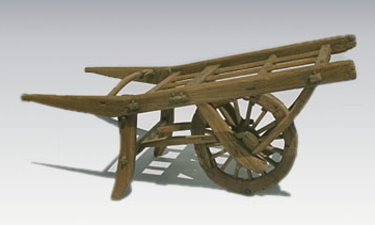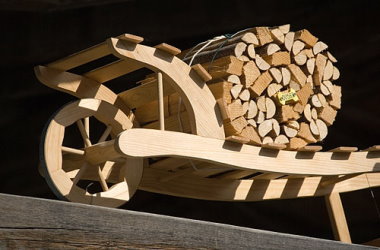Wheelbarrow
Explain how Europe benefited from cultural diffusion during the period c. A.D. 1000 - 1500.

Modern Wheelbarrow
A wheelbarrow is a small hand-propelled vehicle, usually with just one wheel, designed to be pushed and guided by a single person using two handles to the rear. In ancient times, a sail could be used to guide the wheelbarrow by wind.
The term wheelbarrow
is made of two words: wheel
and barrow.
Barrow
is a derivation of the Old English bearwe
which was a device
used for carrying loads. Because the word barrow
is not in common use in English
today, many people incorrectly substitute the word barrel
in place of barrow
as this seems to make more sense - possibly because the cavity in a modern wheelbarrow
resembles a half-barrel.
The wheelbarrow was first invented in ancient Greece. Although evidence for the wheelbarrow in ancient farming and mining is absent, it is believed that wheelbarrows were common on Greek construction sites for carrying moderately light loads and may have been adopted by the Romans.
While the present evidence does not indicate a continuing use of wheelbarrows into medieval times, they may have been used in the Byzantine Empire. Possibly the concept of the wheelbarrow was even transmitted to China before disappearing in Western Europe.

Two Wheel Chinese Wheelbarrow

One Wheel Chinese Wheelbarrow
The earliest depictions of Chinese wheelbarrows come from 2nd century Han Dynasty tomb murals and brick tomb reliefs. The painted tomb mural of a man pushing a wheelbarrow was found in a tomb at Chengdu, Sichuan province, dated precisely to 118 AD.
Unlike the wheelbarrow innovated later in medieval Europe, with a front wheel meant to carry fairly light loads, the central wheel and axle of wheelbarrows in China allowed their wheelbarrows to haul considerably heavier weights. However, the lower carrying surface made the European wheelbarrow clearly more useful for short-haul work. The Chinese also developed two-wheeled barrows for heavier loads and even as a form of transportation.

Medieval Wheelbarrow
The wheelbarrow reappeared in Europe sometime between 1170 and 1250. By the 13th century, the wheelbarrow proved useful in building construction, mining operations, and agriculture. However, going by surviving documents and illustrations it remained a relative rarity until the 15th century. It also seemed to be limited to England, France, and the Low Countries of Belgium and the Netherlands.
Medieval wheelbarrows featured a wheel at or near the front - in contrast to their Chinese counterparts, which typically had a wheel in the center of the barrow. This European design is now the standard design of modern wheelbarrows.
